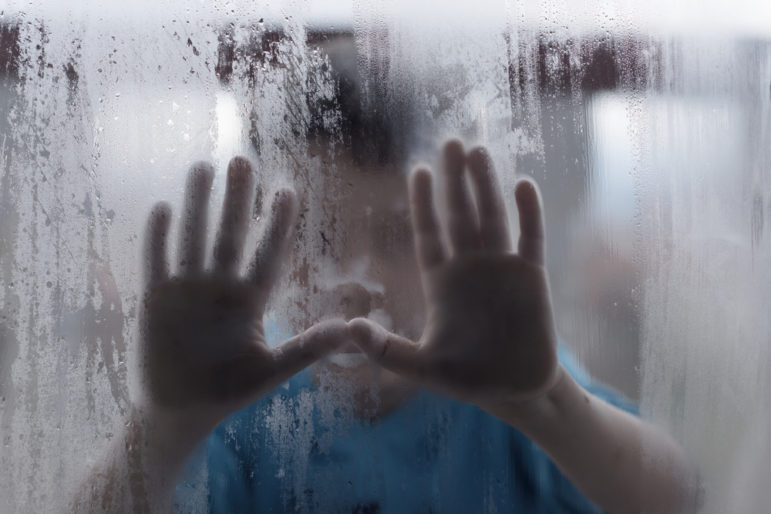
Amir Bajrich/Shutterstock
.
Jolene Martinez of Las Cruces couldn’t be more thrilled to be an adoptive parent to a second foster child, who she adopted weeks before Thanksgiving. “The joy for our family is being able to fulfill what we believe in, and that’s to help a child that might not be able to have permanency otherwise,” she said.
But for many foster and adoptive families in the state, there are lows with the highs as well as extraordinary challenges. New Mexico children aren’t just one of the state’s most vulnerable populations, they’re also one of the nation’s most challenged groups. In 2017 and 2018, New Mexico ranked 50th nationwide in overall child well-being, according to the Annie E. Casey Foundation Kids Count report.
The overburdened and understaffed Children, Youth, and Families Department (CYFD) is often placed at the center of the blame game for New Mexico’s dismal child well-being outcomes, but there are complex and systemic issues, such as generational poverty and a drought of behavioral health services, that contribute to New Mexico’s splintered foster care and child welfare systems.
Martinez, a former CYFD caseworker, is also the clinical director of the Las Cruces-based Families and Youth, Inc. (FYI), which provides preventive, intervention and treatment services to children and families in a range of settings, such as health care, child welfare, mental illness and emergency shelter. During her tenure in the field, she’s witnessed families and children struggle under a bulky accumulation of complicated and entangled issues.
“Historically, it’s not uncommon to see a family struggling with poverty and substance abuse, but now you’re seeing poverty, substance abuse, mental illness, complex trauma and long family histories of abuse and neglect piled on top of each other,” Martinez said. “The substance abuse problem has also gotten much more complex than it was in the ’80s and ’90s.”
As a result, a youth in care can be dealing with a host of challenges. Foster parents are initially trained to help a child through the ordeals that are front and center. But then the child’s needs pivot, and adoptive families are often left to try to figure out solutions by themselves due to a deficit of post-adoption services, Martinez said.
“We might adopt a child at age 10 and their mental health needs change at 12, 14 or 16. A lot of us are left to navigate that system alone,” Martinez said, adding New Mexico is also short on respite foster care, where one foster family temporarily cares for another family’s foster youth in order to give the child’s original foster family a short-term break.
‘Surrendering services’
Doña Ana County has been hard hit by the repercussions of former Gov. Susana Martinez’s 2013 decision to choke off Medicaid funding for 15 of the state’s private behavioral health providers, she said, which resulted in many mental health services closing up shop.
“There was chaos,” Martinez said. “A lot of families lost their providers and their services. It has changed the economic landscape of behavioral health. A lot of the providers that used to work in community mental health centers were driven to private practice so families are still having difficulty with one coordinated system of care.
“We’re trying to rebuild the community mental health model where a family can come to our agency and receive services in one space as an adult and as a youth,” she said. “It has been both a user issue and also a workforce issue … it’s difficult to recruit therapists in an environment where a lot of these individuals are working for themselves.”
[Related: New Mexicans See Foster Care Challenges, But Are Encouraged by Changes]
[Related: In Santa Fe, NM, ‘We’re Not Going to Play the Blame Game’]
[Related: Lack of Affordable Housing, Enough Foster Families Hurt Taos, NM, Area]
[Related: Carlsbad, NM, Oil Windfall Makes It Harder to Keep Caseworkers]
The lack of services and funding in the state has systematically impacted FYI, which serves far-flung areas such as Truth or Consequences, Deming and Sunland Park. Martinez estimates that FYI used to assist at least 50 to 60 families in Doña Ana County. In 2018, it dwindled to 15 to 20 families, with the remainder of FYI’s stretched-thin services dispersed to places like Socorro and Alamogordo.
“Instead of making a more global impact in one area, we’re making these micro impacts in these communities, which leaves an area like Doña Ana County really underserved,” Martinez said. In fiscal year 2019, nearly 12% of CYFD’s central intake reports of abuse and neglect came from Doña Ana County, the second highest number in New Mexico behind Bernalillo County, according to CYFD’s 360 Annual Report.
“We’re surrendering services in a big population to serve a community like Sierra County, where [the referral rate] is less than 1%, or Alamogordo, where it’s less than 6%,” she said. “They still need services because these communities are also depleted, but it leaves a community like Doña Ana County exposed.”
As state officials attempt to reform child well-being — lawmakers created a new Early Childhood Education and Care Department during the 2019 Legislature — Martinez says she’ll continue doing the best she can for her children.
“Adoption, even though we celebrate it, is really a tragedy of the system. For my children, I would’ve hoped they lived safely with their birth parents,” she said. “Even though they can’t, we’re going to move forward with resiliency for them.”
This story is part of a Youth Today project on foster care in New Mexico. It’s made possible in part by the May and Stanley Smith Charitable Trust. Youth Today is solely responsible for the content and maintains editorial independence.




























